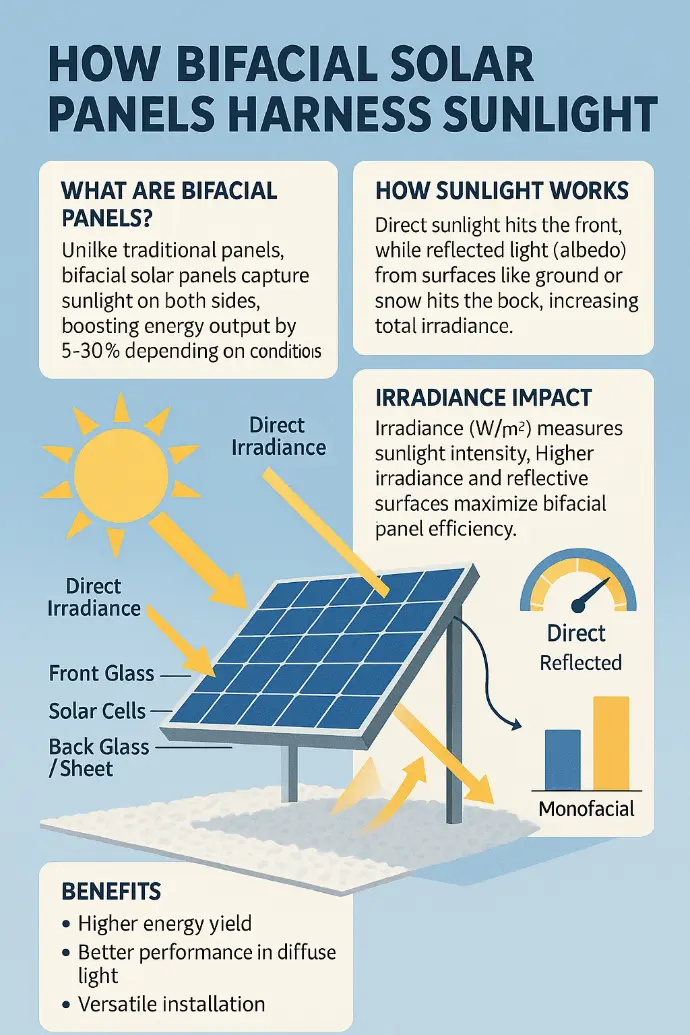Bifacial Panels: What You Should Know
Solar panels are getting better and smarter every day. One of the newest and most exciting changes is the rise of bifacial solar panels. These are not your regular panels—they don’t just collect sunlight from the top, but also from the back, using light that bounces off the ground. That’s what bifacial solar panels do—they collect sunlight from both sides and can produce up to 30% more energy than regular panels. As solar technology keeps improving, these two-sided panels are becoming more popular because they can give you more power without needing more space. In this post, we’ll break down what bifacial panels are, how they work, and what you should know before deciding if they’re right for you. Want to know if these panels live up to the hype? Let's take a closer look.
What Is a Bifacial Solar Panel?
Bifacial solar panels are special types of solar modules that can absorb sunlight from both the front and the back. Unlike traditional monofacial panels that only collect sunlight from one side, bifacial panels have solar cells on both surfaces. This means they can make use of not just direct sunlight but also the light that reflects off the ground or nearby surfaces. This design helps them produce more energy, especially in places with bright or reflective surfaces like snow, sand, water, or even white-painted rooftops.
These panels are usually made with a glass front and either a glass or clear backsheet, which makes them look transparent and modern. They are often slim and frameless, giving them a sleek appearance that’s a bit like thin-film panels. Most bifacial panels are made with monocrystalline solar cells for higher efficiency, although some use polycrystalline cells. Because they can capture more light, they are a smart option for anyone looking to get more power without needing more space.
Key Features of Bifacial Solar Panels
Dual-side power generation: They collect sunlight from both the top and the bottom, increasing overall energy production.
Higher energy output: Bifacial panels can produce 10–30% more power than standard panels, especially when placed over reflective ground (like white concrete, sand, or gravel).
Works like a regular panel if needed: You can mount them on rooftops or other traditional setups, but you’ll mostly be using just the front side—like a monofacial panel.
Best used in open, elevated settings: These panels perform best when there’s space underneath and reflective material below.

How do they work
The front side of a bifacial panel functions just like a traditional solar panel, converting direct sunlight into electricity. This is the primary source of energy generation, and it's what we've come to expect from solar panels. The Rear Side? Here's where things get interesting. The rear side of a bifacial panel captures diffused and reflected sunlight from the ground or surrounding surfaces. This additional energy source can significantly boost the panel's overall efficiency and energy output.
Advantages of Bifacial Panels
As solar technology advances, bifacial panels are poised to become the new norm. Their ability to generate more energy per panel without requiring additional space makes them an attractive solution for solar projects. It offers several advantages over traditional, monofacial panels. Here are some key advantages.
- More Energy Output
They generate power from both sides, giving you up to 10–30% more electricity compared to regular panels. -
Better Use of Space
You can produce more power without adding more panels, which is great when space is limited. -
Higher Efficiency in Reflective Environments
Surfaces like white roofs, sand, concrete, or water help bounce light to the back side, boosting energy production. -
Stronger and More Durable
Many bifacial panels are made with glass on both sides, making them resistant to weather and wear. -
Improved Performance in Low Light
They can capture scattered and reflected light, helping them work well even on cloudy days or early/late in the day. -
Longer Lifespan
Their sturdy design often means a longer operational life and better warranties, typically 25 years or more. -
Lower Cost Per Watt (Over Time)
While they cost more at first, their extra energy output often leads to better savings and returns over time. -
Versatile Installation Options
Can be used in ground-mounted systems, solar carports, rooftops, pergolas, and more—even though rear-side gains vary by setup.
Conclusion
Bifacial solar panels are a smart, forward-thinking choice for anyone ready to embrace the future of clean energy. With their ability to boost power output, save space, and adapt to diverse setups, they offer unmatched efficiency and sustainability. Whether you’re powering your home, business, or a large-scale solar project, these panels deliver more energy while reducing your environmental impact. Dive into the world of bifacial solar today and light up your energy journey with a solution that’s as innovative as it is eco-friendly! Shop Bifacial Solar panels from Our Store